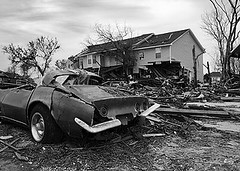Thursday, August 24, 2006
Hurricane Katrina Overview: 4 page handout from Wikipedia.org
Katrina & New Orleans : a brief overview
Hurricane Katrina was the costliest and one of the deadliest hurricanes in the history of the United States. It devastated the Gulf Coast over 100 miles away from its center, according to Wikipedia.org.
* Formed over the Bahamas on August 23, 2005
* Crossed southern Florida as a Category 1 hurricane.
* Strengthened in the Gulf of Mexico.
* Second landfall was in La. as a Category 3 on Aug 29.
*
* Caused catastrophic damage along the coastlines of
- Alabama,
- Mississippi
- Louisiana
And to the municipalities of
- Mobile (AL),
- Biloxi (MS)
- Gulfport (MS)
- Slidell (LA).
* Levees separating Lake Pontchartrain from New Orleans were breached by the surge, ultimately flooding roughly 80% of the city and areas of neighboring parishes.
* Severe wind damage was reported well inland.
* Katrina damages estimated at $75 billion.
- Costliest hurricane in U.S. history.
- 1,836 people dead.
* Criticism of the federal (George Bush), state (Kathleen Blanco, governor) , and local government's (Ray Nagin, mayor) response to the storm was widespread:
- Investigation by US Congress.
- Resignation of FEMA head Michael Brown.
*
* By August 26, an unprecedented cataclysm was already being considered, since 80% of the New Orleans metropolitan area is below sea level.
* Previous studies by FEMA and the Corps of Engineers warned that a direct strike could lead to massive flooding, which would lead to thousands of drowning deaths.
* On August 28, New Orleans mayor Ray Nagin ordered the first ever mandatory evacuation of the city, calling Katrina, "a storm that most of us have long feared".
* Refuges of Last Resort established for citizens who could not leave the city. Example: Louisiana Superdome, which sheltered approximately 26,000 people.
On Aug 29, Katrina's storm surge caused breaches in drainage and navigation canal levees. Water flowed from the lake into low areas of the city.
*
New Orleans' levee failures:
- primarily the result of system design flaws
- also caused by lack of adequate maintenance, acc. to the National Science Foundation.
Storm surge also devastated the coasts of Mississippi & Alabama, making Katrina the most destructive and costliest natural disaster in the history of the US.
* Total damage estimated at $75 billion, nearly double the cost of the previously most expensive storm.
* Federal disaster area: 90,000 square miles, an area almost as large as the United Kingdom.
* An estimated 3 million people were without electricity.
Landfall on Aug 29 brought 125 mph winds & storm tide in excess of 14 feet.
- Rainfall of 8-10 inches to a high of 15 inches.
- Several bridges were destroyed, including the I-10 twin span connecting Slidell to New Orleans.
- The Mississippi River Gulf Outlet (MR-GO) breached its levees in approximately 20 places, flooding much of east New Orleans and most of Saint Bernard Parish.
August 29 : most of the windows on the north side of the Hyatt Regency had been blown out; other high rise buildings had extensive window damage. The Hyatt was the most severely damaged hotel, with beds reported to be flying out of the windows. Insulation tubes were exposed as the hotel's glass exterior was completely sheared off.
* The Superdome, which was sheltering a large number of people who had not evacuated, sustained significant damage.
* Louis Armstrong New Orleans International Airport was closed before the storm and was flooded.
* Over 700 bodies were recovered in New Orleans. Some survivors reported seeing dead bodies lying in city streets and floating in still-flooded sections.
* Oil & gas production from the Gulf of Mexico was curtailed by approximately 24%.
* Forestry industry loss was about $5 billion.
Hundreds of thousands of residents were left unemployed. Taxes paid to local governments will shrink.
Katrina also redistributed New Orleans' population across the southern United States.
January 2006: New Orleans population is about 200,000 people; that is less than half of the pre-storm population.
* Insurance companies have stopped insuring the area and have raised insurance premiums to cover their risk.
* Storm surge caused severe beach erosion, in some cases devastating coastal areas. The storm obliterated the Chandeleur Islands.
* Breeding grounds for marine mammals, turtles, birds and fish were lost.
* Flood waters that covered New Orleans were pumped into Lake Pontchartrain. These residual waters contain a mix of raw sewage, bacteria, heavy metals, pesticides, toxic chemicals, and about 6.5 million gallons of oil.
Over seventy countries pledged monetary donations or other assistance, including Kuwait (pledge of $500 million), Qatar ($100 million), India, China (both $5 million), Pakistan & Bangladesh.
* Canada, Mexico, Singapore, and Germany sent supplies, relief personnel, troops, ships and water pumps to aid in the disaster recovery. Russia and France also sent aid.
*
Subscribe to:
Post Comments (Atom)


No comments:
Post a Comment